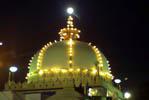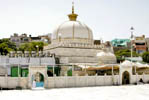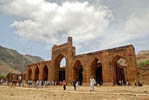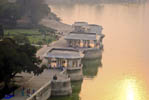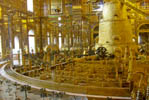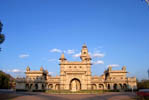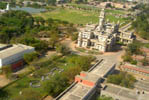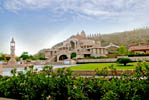Just over 130 km south-west of Jaipur is Ajmer, a burgeoning town on the shore of the Ana Sagar Lake, flanked by barren hills. Historically, Ajmer had considerable strategic importance and was sacked by Mohammed Gauri on one of his periodic forays from Afghanistan. Later,
it became a favourite residence of the mighty Mughals. One of the first contacts between the Mughals and the British occurred in Ajmer, when Sir Thomas Roe met with Jehangir here in 1616.
The City was subsequently taken by the Scindias and, in 1818, it was handed over to the British, becoming one of the few places in Rajasthan controlled directly by the British rather than being part of a princely state. The British chose Ajmer as the site for Mayo
College, a prestigious school opened in 1875 exclusively for the Indian Princes, but today open to all those who can afford the fees. Ajmer is a major centre for Muslim pilgrims during the fast of Ramadan, and has some impressive Muslim architecture. However for most
travellers, Ajmer is essentially just a stepping stone to nearby Pushkar. It can make a convenient base if you can't get accommodation in Pushkar during the Camel Fair.
TOP
PLACES OF INTEREST ARE:
Dargah Sharif: At the foot of a desolate hill in old part of town, this is one of India's most important places for Muslim pilgrims. The Dargah is the Sufi saint, Khawaja Muin-uddin Chishti, who came to Ajmer from Persia in 1192. Construction of the Shrine was
complete by Humayun and the gate was added by the Nizam of Hyderabad. Akbar used to make the pilgrimage to the Dargah from Agra once a year. You have to cover your head in certain areas so don't forget to take a scarf or caps.
As you enter the courtyard, removing your shoes at the gateway, a mosque constructed by Akbar is on the right. The large iron cauldrons are for of ferigs which are customarily shares by families involved in the shrine upkeep. In an inner court there is another mosque
built by Shah Jahan. Constructed of white marble it has II arches and a Persian inscription running the full length of the building.
The saint's tomb is in the centre of the second court, it has a marble dome and the actual tomb inside is surrounded by a silver platform. The horseshoes nailed to the shrine doors are offerings from successful horse dealers! Beware of 'guides' pestering for donations
around the Dargah using the standard fake donation books or 'visitor register' you'll have to pay a generous donation if you sign up. The tome attracts hundreds of thousands of pilgrims every year on the anniversary of the saint's death, the Urs, in the seventh month
of the lunar calendar. It's an interesting festival, but the crowds can be suffocating. As well as the pilgrims, Sufis from all over India converge on Ajmer.
Ana Sagar & Foy Sagar: This artificial lake was created in the 12th century by damming the River Luni. On its bank is a pleasant park, the Daulat Bagh, containing a series of marble pavilions erected in 1637 by Shah Jahan. There are fine views from the hill
beside the Daulat Bagh. Another reservoir Foy Sagar was constructed in 1891-1892 A.D. by the Ajmer Municipal Committee. Foy was the Executive Engineer in-charge of the project.
Adhai-din-ka-jhonpra: A remarkable structure, this is a masterpiece of indo - Islamic architecture located on the outskirts of the city, just beyond the Dargah As the legend goes, its construction took two and a half days (Adhai-Din) to complete. It was originally
a Sanskrit college, built within a temple.
In 1193 A.D., Mohammed Ghauri conquered Ajmer and converted the building into a mosque by adding a seven arched wall in front of the pillared hall in just two-and-half days (adhai-din) and hence the name. The distinct pillars and arched "Screen" with its
ruined minarets make it a splendid architectural masterpiece.
Taragarh Fort: Taragarh, also known as Garh Beetli, is a circumvallation of the crest of the hill which overhangs the town of Ajmer and commands a view of it from every point. The principal strength of the fort lies in the ruggedness and acclivity of the hill.
The space within the walls of this hill fort was about 32 hectares with several tanks. From 1818 to 1832 A.D., a company of Native Infantry occupied it, but the fort was dismantled in 1832 A.D., from 1860 to 1920 A.D., other accommodation on the hill was used as the
sanitarium for the European troops stationed at Nasirabad. It is now in a dilapidated and forlorn state though the hill still commands a majestic view.
Mayo College: lord Mayo, the Viceroy of India, in a Darbar held in 1870 A.D. at Ajmer, which was attended by several ruling princess of States of Rajputana, placed before them a proposal to set up an institution at Ajmer for the education of princess and sons of nobility.
Its foundation stone was laid in 1878 A.D. and its building, constructed in white marble in Indo Saracenic style, was inaugurated by the Maruis of Dufferin, in 1885 A.D. Sometimes known as the Eton of India, the institution had the distinction of enrolling several ruling
princes, not only from Rajputana States, But from outside as well. It is now open to all sections of society and is still one of the best schools in the country.
The Circuit House: The former British Residency, overlooking the artificial lake Ana Sagar, has now been converted into the Circuit House. The Ana Sagar Lake and the cenotaph and the shrine of Hindu reformer Swami Dayanand, founder of the Arya Samaj movement in
India, can be viewed from here.
Nasiyan (Jain Temple): Buiilt in 1864-1865 A.D., this Digambar Jain Temple is commonly called Lal Mandir (Red Temple) due to its colour. Behind the temple is a Swarna Nagari Hall containing gilt-edged wooden representations from Jain mythology, which were prepared
at Jaipur.
TOP
MUSEUMS & ART GALLERIES:
Government Museum: situated in the heart of the old city and close to the railway station the museum is housed in the beautiful fort and palace built by the Mughal Emperor Akbar in 1570.
It was here that the British envoy Sir Thomas Roe met Emperor Jahangir in 1616. what is today commonly known as Magazine is the palace quarters where the emperors lived. After British occupation in 1818 and during the first war of Independence in 1857 it was used as the
Rajputana Arsenal by the British which gave the name magazine.
EXCURSIONS
Baghera: Baghera is situated in the Kekri sub-division of Ajmer District. It is about 107 kms. South-east of Ajmer. The village is known for its treasuretove of archaeological and antiquarian relics. It's old name was Vyagreraka as has been recorded in the Bijolia
rock inscription during the reign of the Chauhan Emperor, Someswara, dated v.s. 1226. Baghera attracted the attention of archaeologist A.C.L. Carllyle who examined its relics in 1871-72.
Baghera is well known for its archaeological sites. The most renowned of them all is the temple of Varaha Avtar (incarnation of Lord Vishnu in the form of a boar). It is presently enshrined in a comparatively modern building on the southern side of a big sacred tank
known as Varaha Sagar. On the western side of the Varaha Sagar are the ruins of an ancient temple dating back to 10th-11th century A.D. There is also a magnificent Torana close to the outer wall the Garh (residence) of the Thakur of Baghera. Naginabagh offers a rare
sight of low lying mounds having traces of ancient buildings buried underneath. On the outskirts of Baghera there is a rocky area named Mataji Dungar. Here one can behold a mystifying sight of Jain images jutting out of land. These images mark the site of a famous Jain
temple referred to in the inscriptions of the medieval period.
Todgarh: Todgarh, is picturesque place situated in the Aravallis, the oldest mountain range of the world. Todgarh is 3281 feet above sea level and has the potential of attaining the status of a hill resort, next only to Mount Abu. Captain Tod built the fort of
Todgarh which is about 70 kms from Beawar. It is 120 kms. South of Ajmer, and only 13 kms. from Bhim on National Highway No. 8. Its original name is Boraswara. In early times, nomadic tribes like the Banjaras and Gurjars inhabited this area. Todgarh formed a part of Merwara.
Kishangarh: Kishangarh was the capital of the erstwhile princely State of the same name and was founded in 1611 A.D. by Kishan Singh, as son of the Rathore dynasty of Jodhpur. One of his successors, Raja Sawant Singh, who not only was an accomplished poet, writing
under the nom-de-plume of Nagari Das, but also was a painter of high order. His masterpiece Bani Thani (a bewitching lady personifying everything beautiful in womanhood) immortalized him and gave a new theme and direction to the Kishangarh School of painting. In recent
years the town has become a trade centre for various varieties of marble and papier mache products.
Roopangarh Fort: Built in AD 1648 and called after himself, the town and Fort of Roopangarh was constructed by Maharaja Roop Singh of Kishangarh State between the mid - 17th to 18th centuries. This is called the 'Golden Period' of Kishangarh
Art and Culture, and saw to the flourishing of the world famous school of Miniature Paintings.
Originally a nine turreted Fort, Roopangarh Fort has been built over and added on by several generations and the different styles can still be seen in the structure. Now beautifully restored and renovated into a hotel, it is the first 'War-Fort' to have been done so.
The nineteen large rooms are individually and tastefully decorated, keeping in mind the history and heritage surrounding it.
Beawar: 54 kms from Ajmer. A Badshahi procession festival is celebrated every year on the day After Holi (Dhulandi), wherein large number of people throw gulal (dry colour) on each other.
TOP
SHOPPING:
The leather work of Rajasthan is interestingly a joint effort of the local men and women. While the men do the tanning, cutting and stitching, the women do embroidery and ornamentation.
In Ajmer, you will find numerous items that are truly Rajasthani and reflect an ancient tradition. Silver and gold ornaments, jewellery, tie-and-dye sarees and embroidered Jodhpuri shoes are some of this city's specialities. During the annual Urs fair, folk artisans
display their ware and offer a tempting range of intriguing and colourful items. Prominent shopping centres include Madar Gate, Station Road, Purani Mandi, Naya Bazar, Kaisarganj, Nala Bazar etc. |







